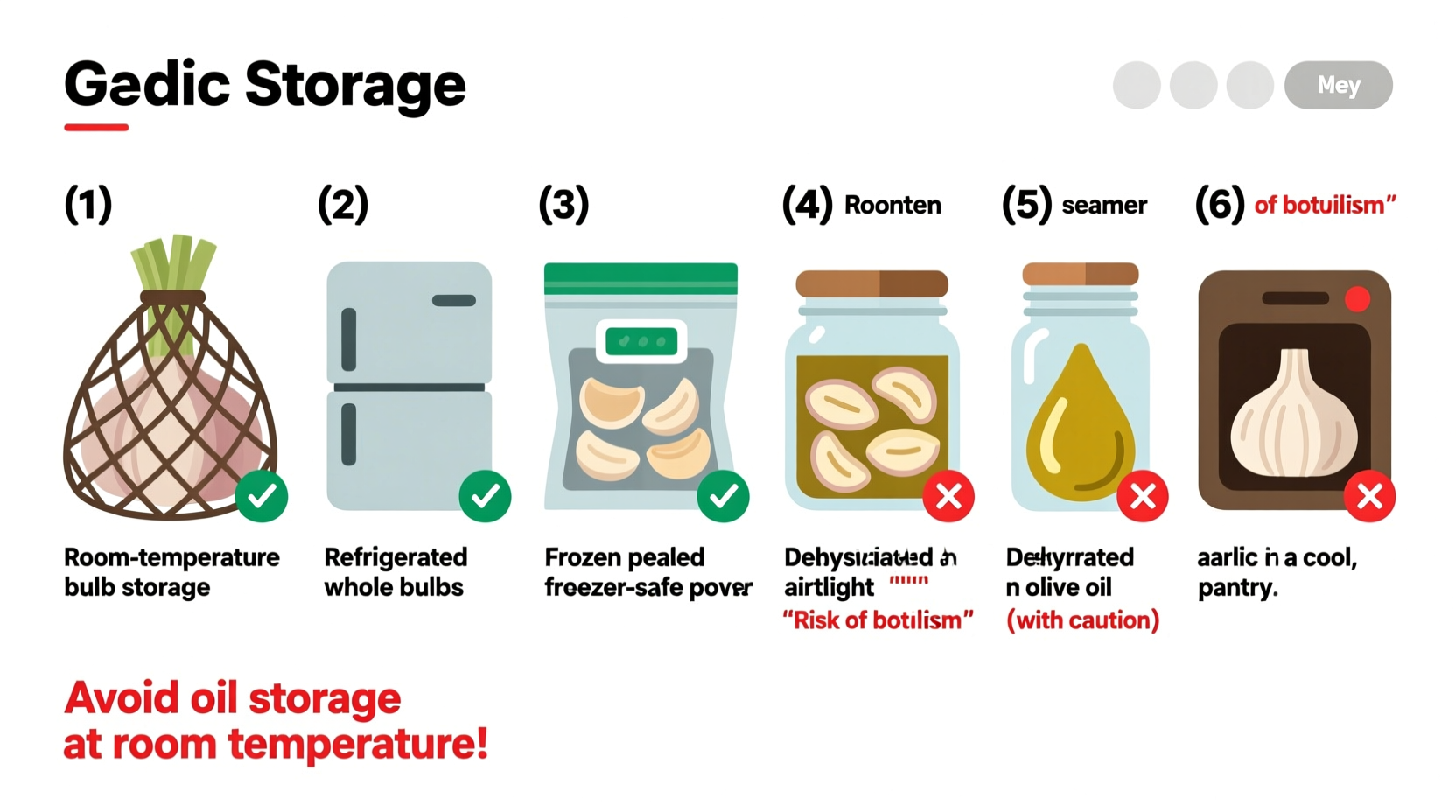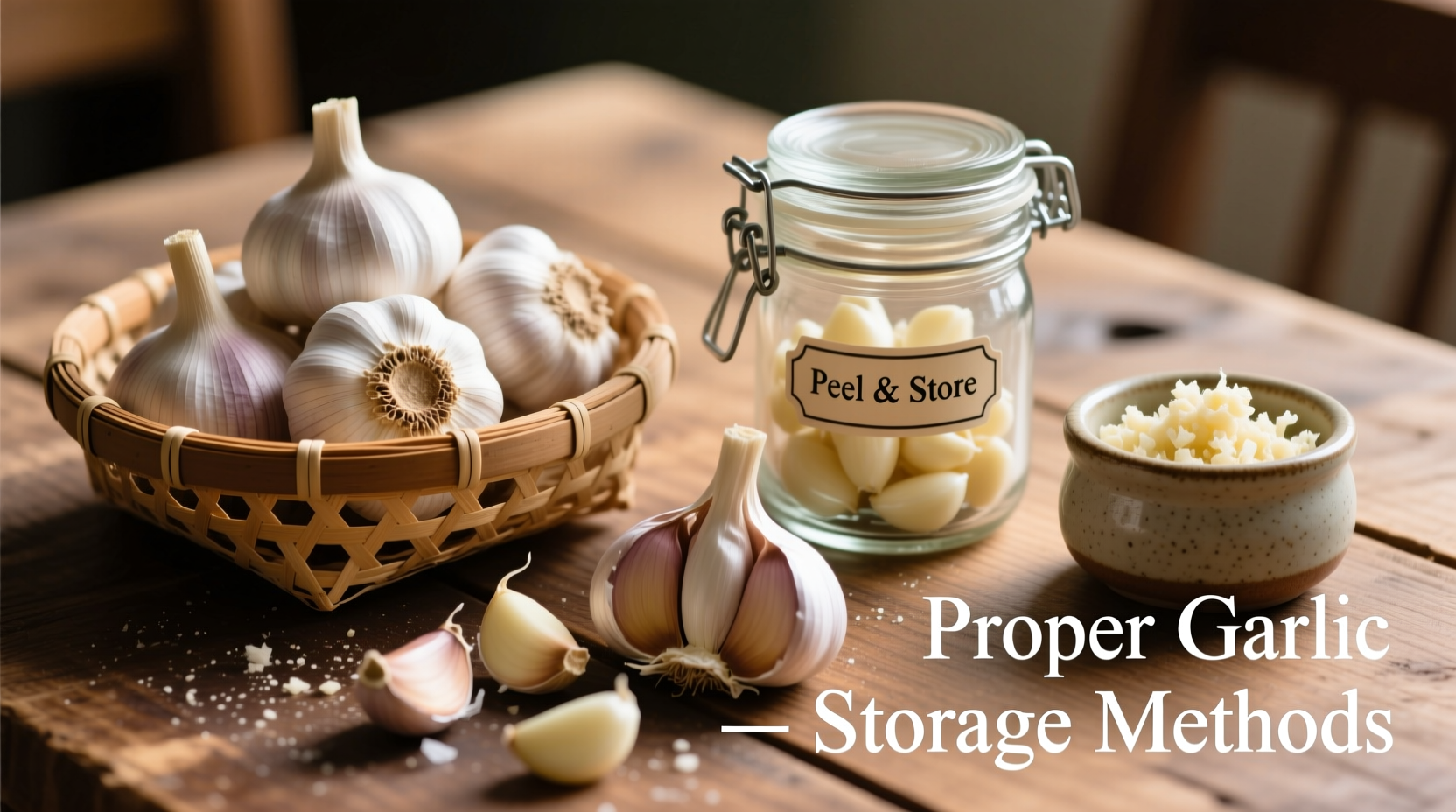Discover exactly how to maximize your garlic's shelf life with science-backed storage methods that prevent sprouting, mold, and flavor loss. Whether you've got a farmer's market haul or just opened a supermarket bulb, these practical techniques will keep your garlic fresh and potent for cooking.
Why Proper Garlic Storage Matters
Garlic isn't just a flavor powerhouse—it's a living plant product that continues metabolic processes after harvest. Improper storage triggers sprouting, mold growth, and texture degradation. According to USDA food safety guidelines, maintaining proper temperature and humidity prevents Aspergillus niger mold development, which commonly affects improperly stored garlic. The right storage method preserves allicin—the compound responsible for garlic's distinctive flavor and health benefits—for optimal culinary results.
Garlic Storage Methods by Timeframe
Choose your storage approach based on how quickly you'll use your garlic. Different methods serve different needs in the home cook's journey from purchase to plate.
Short-Term Storage (1-4 Weeks)
For garlic you'll use within a month, room temperature storage works best. Keep whole bulbs in a well-ventilated container away from direct light:
- Mesh bags or wire baskets—allow maximum air circulation
- Ceramic garlic keepers—provide darkness while allowing ventilation
- Braided garlic—traditional method that keeps cloves accessible while maintaining proper conditions
Avoid plastic bags or airtight containers, which trap moisture and accelerate spoilage. The University of California Agriculture and Natural Resources confirms that garlic stored at 60-65°F (15-18°C) with 60-70% humidity maintains quality significantly longer than in refrigerated conditions.
Medium-Term Storage (1-3 Months)
When you need to extend garlic's shelf life beyond typical room temperature storage:
| Method | Duration | Best For | Preparation |
|---|---|---|---|
| Unpeeled whole bulb in pantry | 3-5 months | Most home cooks | Store in mesh bag away from heat sources |
| Peeled cloves in oil | 10-14 days | Immediate cooking needs | Refrigerate in airtight container; use within 2 weeks |
| Peeled cloves in vinegar | 1-2 months | Pickling applications | Cover with vinegar in sterilized jar; refrigerate |
Important food safety note: Never store garlic in oil at room temperature. The National Center for Home Food Preservation warns this creates ideal conditions for Clostridium botulinum growth, which causes botulism. Always refrigerate garlic-in-oil mixtures and use within 2 weeks.
Long-Term Storage (6+ Months)
For preserving large harvests or seasonal bargains:
- Freezing method—peel cloves, place in freezer bag with air removed, freeze for up to 12 months. Frozen cloves can be grated directly into dishes.
- Drying/dehydrating—slice cloves thinly and dehydrate at 135°F (57°C) until brittle, then store in airtight container with oxygen absorber.
- Garlic powder—grind dehydrated garlic to powder and store in dark glass jar.
Cornell University's Food Science Department confirms that properly frozen garlic maintains 90% of its allicin potential for up to one year, making it the most effective long-term storage method for preserving garlic's characteristic flavor compounds.

Critical Mistakes That Ruin Garlic
Avoid these common errors that dramatically shorten garlic's shelf life:
- Refrigerating whole bulbs—causes premature sprouting and texture changes
- Storing near heat sources—kitchen stoves and ovens accelerate deterioration
- Keeping in plastic containers—traps moisture leading to mold
- Washing before storage—adds moisture that promotes spoilage
- Storing with potatoes—potatoes release moisture and gases that make garlic sprout faster
How to Tell When Garlic Has Gone Bad
Recognize these spoilage indicators before using garlic in your cooking:
- Texture changes—soft spots, mushiness, or excessive dryness
- Color changes—yellow or brown spots inside cloves
- Sprouting—green shoots emerging (still safe but flavor changes)
- Mold—fuzzy white, green, or black growth
- Odor—sour or unpleasant smell instead of characteristic pungency
According to FDA food safety guidelines, discard garlic showing significant mold growth or slimy texture. Small sprouts can be removed and the remaining garlic used immediately, though the flavor profile will be milder with slightly bitter notes.
Special Storage Considerations
Adapt your storage approach for these specific situations:
- Peeled cloves—store in airtight container in refrigerator for up to 1 week
- Minced or chopped garlic—cover with olive oil in small container, refrigerate, and use within 5 days
- Roasted garlic—store in airtight container in refrigerator for up to 1 week
- Softneck vs. hardneck varieties—hardneck varieties typically have shorter shelf life (3-4 months) compared to softneck (6-8 months)
For home gardeners, the USDA recommends curing freshly harvested garlic by hanging in a warm, dry, shaded area with good air circulation for 2-3 weeks before moving to long-term storage conditions. This curing process significantly extends shelf life by allowing protective skin layers to dry properly.
Practical Storage Solutions for Every Kitchen
You don't need specialized equipment to store garlic properly. Try these accessible solutions:
- Repurpose a clean onion bag or citrus fruit netting as a breathable storage container
- Use a terra cotta garlic keeper (available at most kitchen stores)
- Create a DIY storage container by punching holes in a paper bag
- Store in a small wooden bowl on your countertop away from direct sunlight
Remember that garlic continues to develop flavor compounds even in storage. The University of Maine's Cooperative Extension notes that garlic stored at cooler temperatures (55-60°F) develops more complex flavor profiles over time compared to warmer storage conditions.











 浙公网安备
33010002000092号
浙公网安备
33010002000092号 浙B2-20120091-4
浙B2-20120091-4